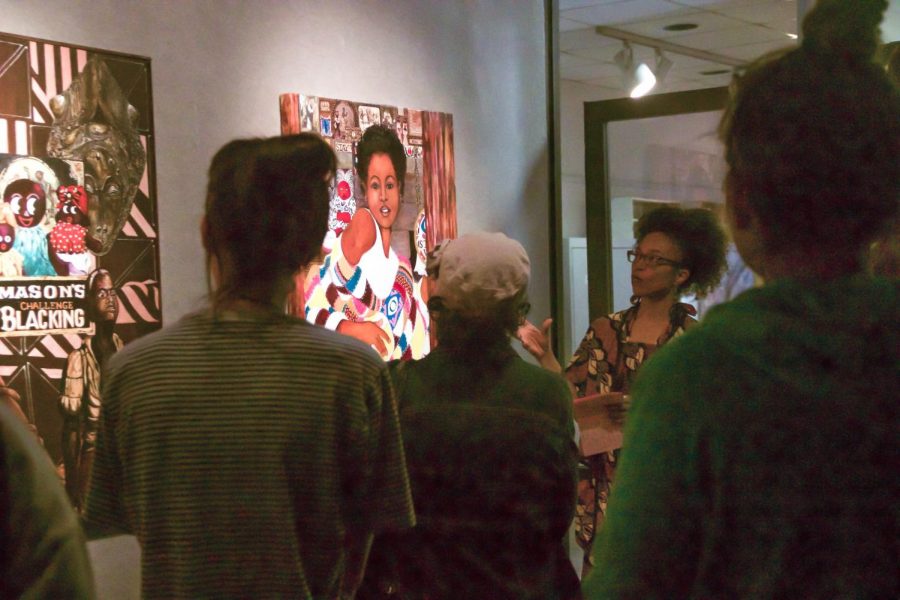Anna L. Stanley-Mullone presents ‘Stronger Than Chains’ art exhibit
ONE MOUTH, TWO EARS: Monroe community members of all ages listen intently to learn about Stanley-Mullone’s work.
March 20, 2018
Imagine growing up hearing stories about your mother deciding whether to pay for groceries or pay a poll tax to vote. What if you were only allowed to swim in a public pool once a year-the Fourth of July-because of your skin color?
Experiences like this are what inspired the paintings of Fort Worth native Anna L. Stanley-Mullone that were displayed for nearly a month in Bry Art Gallery (Feb. 19-Mar. 15).
Stanley-Mullone was scheduled to discuss her work on Thursday, the last day to view her artwork in Bry, but her daughter, ULM associate dance professor Tina Mullone, took her place instead.
“If you don’t talk about it, you’re doomed to repeat it,” is the motto Mullone echoed from her mother being asked why she consistently chose the same subject matter.
Amid the Jim Crow South, Stanley-Mullone studied graphic design, English and Spanish before graduating in 1965 from North Texas State University, now the University of North Texas.
Inspired by the Black Arts Movement and Dutch painters, she wanted her work to reflect often forgotten parts of African American history and created the “Stronger Than Chains” exhibit.
Paintings like “Good Friday Fish Catch” and “Late To Mass” depict scenes that many blacks growing up in the late 20th century can relate to. The latter painting shows Stanley-Mullone’s three granddaughters.
Mullone explained that her nieces were en route to mass in New Orleans and have been “instructed to stay together, focused and to never look at the ‘Voodoo House.’”
“Voodoo is actually a religion that is a blending of Yoruba faith as well as Catholicism,” Mullone added; it allowed enslaved Africans to preserve their culture under another religion.
Voodoo symbolism is a major influence in many of Stanley-Mullone’s works. By adding this symbolism to her storytelling paintings, she hopes to break the negative stereotypes regarding the religion.
The voodoo aspects intrigued many visitors, but they weren’t senior art major Aidan Warren’s favorite. Her favorite was “Nyumba! Home!” which depicted a broken ship and ghosts because of its story involving slaves who made a pact to kill themselves by throwing themselves overboard after they realized they weren’t in mother Africa anymore.
“Hearing this story brought tears to my eyes and made me really think about some of the modern day struggles that African Americans face today,” Warren said.
When it comes to Stanley-Mullone’s creative process, a center image or idea is usually the focus, but she doesn’t follow a specific path to finish a piece of art. This process can take anywhere from six weeks to six months depending on her mother’s mood, according to Prof. Mullone.
Anna Stanley-Mullone made about 12-14 paintings in a span of about 18 months after her son’s death in 2014. Mullone remembers her mother fervently working on several paintings as a form of therapy.
One interesting thing that Mullone described about her mother working was the order in which a piece came together.
As she walked through the gallery, she described her mother starting with the hair in a Nina Simone inspired piece entitled “Aunt Sarah…Saffronia…Sweet Thing…Peaches!!,” because she wanted black women to be empowered by their hair.
This painting intrigued freshman toxicology major Rashonda Azore, who came to see the exhibit. “When I discovered that a black female artist’s work will be on campus, I thought that it was a must to see the work,” Azore said.
Mullone also described her mother starting with the eyes in “Ready For Your Close-Up, Mr. Charlie?” which depicted black, minstrel show-like caricatures as brushdolls.
While reminiscing, Mullone affectionately added that the eyes always creeped her out at night.
The lecture concluded with a small reception and an invitation to ask any questions that remained about her mother’s work.



